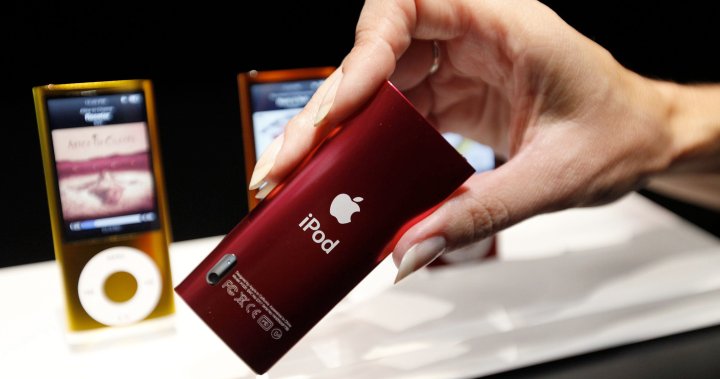In the summer of 2001, a Hollywood screenwriter friend of mine got a call from his agent: “Get up to San Francisco now. There’s an interesting project available and you need to be there for the pitch”
“San Francisco? Can you narrow it down?”
There was a pause. “Report to One Infinite Loop in Cupertino. Apple headquarters.”
My friend and his writing partner were soon sitting in the lobby with confused looks on their faces — What are we doing here? — when a thin guy in jeans and a black turtleneck came by. “Come with me,” he said. It was Steve Jobs.
Read more:
How our music is shaped by technology
For the next 45 minutes, Jobs went into full presentation mode for this audience of two before dramatically reaching into his pocket and pulling out a white slab about the size of a deck of cards.
“Imagine,” he said, “one thousand songs in the palm of your hand.” He held out a prototype for the first generation iPod.
The gig involved writing a promotional video that would be sent to members of the press and the industry ahead of the product launch that fall. Naturally, my friend and his partner took the job with Steve micromanaging everything along the way. It wasn’t uncommon for the phone to ring at 11 p.m. to hear “It’s Steve. I’ve got some notes on the last draft. Ready?”
Unfortunately, the video was never made. The musicians originally contracted to appear had to bow out, timelines grew increasingly tight, and budgets had to go elsewhere. As a consolation, Apple paid the two writers with a pile of Mac PowerBooks. Literally a pile of laptops that took up a corner of the house for months.
My friend was under an NDA so he couldn’t talk about anything until after the iPod was released on Oct. 23, 2001, in the foggy, confusing months following the September 11 attacks. And even then, relatively few people were paying attention.
At first, the iPod would only sync with Macs with iTunes installed. When Bill Gates first saw an iPod, his reaction to that was “Wow. Too bad.” But when a software update made iTunes available for Windows in October 2002, everything changed. Within a year, the iPod had become the consumer electronics device coveted by everyone.
My first in-person exposure came through a co-worker in the spring of 2003 who had what’s now known as the 3rd Gen Classic model. It was the first iPod with an all-touch interface (no more physical buttons or a wheel that actually turned) and featured a tiny (1.8-inch) 10 GB hard drive capable of holding about 2,000 songs. Clicking the virtual wheel and then tracing a finger around it navigated me through what I later learned were called “nested menus,” taking me through artists, albums, songs, genres, and a few other categories. Operation was slick and intuitive. And white ear thingies? Clever.
Given that I was firmly on Team Windows at the time — not to mention that I couldn’t afford the $500+ for a new music player — I resisted jumping on the bandwagon until the spring of 2004 when I made an impulse purchase of a silver iPod Mini over a lunch hour. It was the size of a big pack of gum and had 4 GB of storage. “I’ll never need more than that,” I said with confidence.
I quickly became addicted to the thing, especially when I went for my weekend jogs. I’d had a digital music player before — something called an RCA Lyra, which was shaped like a big, bloated guitar pick and could hold 60 songs in very low-res audio — but my new iPod Mini was better by many orders of magnitude. It wasn’t long before I realized that 4 GB wasn’t enough, so I gave the Mini to my sister and bought a 20 GB 5th Gen Classic branded by U2 in 2006. And when that wasn’t enough, I stepped up to a 6th Gen Classic with 120 GB.
I passed on all models of the iPod Nano because these tiny choking hazards had no screens and were designed to be on permanent shuffle. But then one night in the late summer of 2007, I saw this commercial.
When the ad ended, I turned to my wife. She recognized that look.
“Must. Have. One,” I stammered. And as soon as the iPod Touch hit stores on Sept. 5, 2007, I bought one with a 16 GB drive. Damn the cost.
For the next year or so, that Touch was always with me. It was the pinnacle of music player technology. How could things possibly get any better or any cooler?
Then it did. When my bulky Nokia (remember them?) phone died, I bought an iPhone 3G in late 2008. It did everything the Touch did. And it was a phone.
Overnight, the iPhone made the idea of a dedicated music player obsolete. And as more and more people got into smartphones, Apple or otherwise, devices like the iPod became less popular. After peaking in 2008 at almost 60 million units sold, the device that once accounted for 40 per cent of Apple’s total revenue, went into an irreversible decline as sales were cannibalized by the iPhone. Soon, iPod sales weren’t even worth their own line item in Apple financial reports. The numbers were included under “Other.”
The Classic was the first to die on Sept. 9, 2014, something loudly protested by those who loved the ability of the 160 GB model to hold 40,000 songs (Quaint, considering that an iPhone can stream some 85 million songs from Apple Music.) The Nano was next to go on July 27, 2017, the same day as the Shuffle, er, shuffled off this mortal coil. (The Mini was replaced by the Nano in the fall of 2005.)
That left only the Touch, which, for a while, was marketed to parents as a starter smartphone-like device for kids. It received its last update on May 28, 2019. The Touch hung on for another three years until Apple announced on May 10, 2022, that once the remaining inventory was sold, that would be it. Within hours, there was a run on the devices at the Apple website (they’re now sold out) and Apple stores around the world.
Even though I haven’t fired up any of my old devices in years, I feel strangely melancholic about the end of the iPod era. If you grew up in the early 2000s, you’ll remember how iPods inserted themselves into popular culture. To be seen with a pair of white wires falling from your ears was to be recognized as a savvy early adopter of the coolest cutting-edge technology. Together with iTunes, the iPod made the current digital realities of music consumption possible. And the technology that went into the iPod became the foundation for the iPhone, still the most popular single consumer electronic device of all time.
Oh, and the iPod also set Apple on the road to becoming a US$2 trillion company. Remember that after the iPod, “Apple Computers” changed its name to just “Apple.”
I still have all my old units, save for the Mini I gave to my sister. I’ll have to get it back so I can line them all up on a shelf as some kind of tribute to the device that changed the way we listened to music.
—
Alan Cross is a broadcaster with Q107 and 102.1 the Edge and a commentator for Global News.
Subscribe to Alan’s Ongoing History of New Music Podcast now on Apple Podcast or Google Play
© 2022 Global News, a division of Corus Entertainment Inc.



